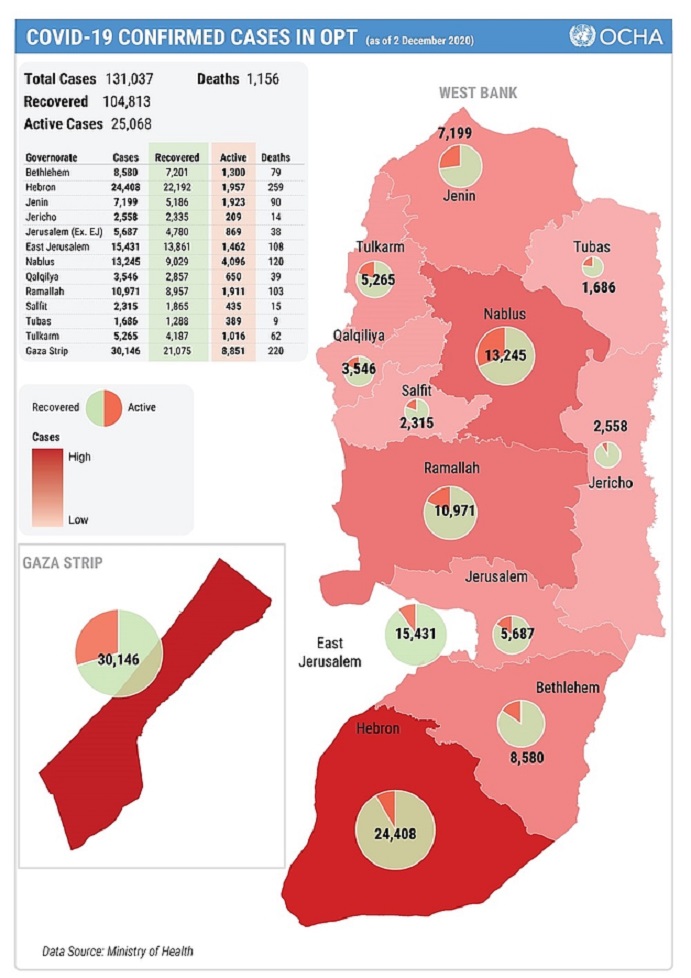OCHA / December 17, 2020
UN Office for the coordination of Humanitarian Assistance
Highlights
- 302 new COVID-19 fatalities, including highest daily death toll since the start of the pandemic.
- Number of patients in intensive care units (ICUs) doubles.
- Another 25,000 cases recorded along with 25,000 recoveries.
- Preparations for a national vaccination plan underway.
Situation Overview
The reporting period witnessed a continuing rise in COVID-19 cases in the oPt, with over 25,000 additional Palestinians testing positive, according to the Palestinian Ministry of Health (MoH). However, the number of active cases rose only slightly, from 23,336 to 25,068, due to the recovery of some 25,400 people. The cumulative number of cases has now reached 131,037. The number of patients in intensive care units (ICU) surged from 67 to 137, including those requiring mechanical ventilation, from 14 to 39.
A total of 302 people died, bringing to 1,156 the cumulative number of fatalities due to the virus, 936 in the West Bank, including East Jerusalem, and 220 in the Gaza Strip. On 12 December, 33 deaths were recorded in the oPt, the highest daily toll since the start of the pandemic. The Case Fatality Rate (CFR), the proportion of deaths among confirmed cases, is approximately 0.9 per cent in the oPt, similar to Israel, but lower than Jordan (1.3 per cent), and Egypt (6.7 per cent).
The availability of testing kits remains a major challenge. On 7 December, testing was interrupted in Gaza, until the World Health Organization (WHO) was able to deliver additional testing kits. WHO, which has been a main supplier of testing kits to Gaza, advises that additional resources are needed from the international community to address priority gaps and that further support is required from the Palestinian Authority (PA) to ensure the equitable and timely delivery of essential medical supplies and equipment to Gaza.
Gaza accounts for 35 per cent of all active cases in the oPt, followed by the governorates of Nablus (16 per cent), Hebron (eight per cent), Jenin (7.6 per cent), Ramallah (7.6 per cent) and the East Jerusalem area (5.8 per cent). The continuing rise in infections has led to new restrictions in both the West Bank and Gaza, as detailed below.
The World Bank has released its latest report on the economic situation in the oPt. Although 121,000 Palestinians became unemployed in the second quarter of 2020, some 50,000 of these regained their jobs the third quarter. Overall, 28.8 per cent the labour force was unemployed by the end of the third quarter, with a stark contrast between Gaza, 48.5 per cent, and the West Bank, 18.2 per cent. The poverty rate is estimated to have increased from 24 per cent in 2018 to 27.5 per cent in 2020. Overall “the outlook for the Palestinian economy looks grim, especially after the second wave of the COVID-19 outbreak” with GDP for 2020 expected to contract by about eight per cent. The World Bank predicts a “modest bounce back” in 2021 with growth returning to about 2.5 per cent, with “consumer and business confidence expected to improve on the assumption of vaccine roll out in the second half of 2021.”
Read the full report :
https://www.ochaopt.org/content/covid-19-emergency-situation-report-24





![vrijdag 17 mei in Amsterdam: in gesprek [videoverbinding] met Palestijnse arts Ghassan Abu-Sittah](https://palestina-komitee.nl/wp-content/uploads/2024/04/abu-Sittha-1-1-218x150.png)







